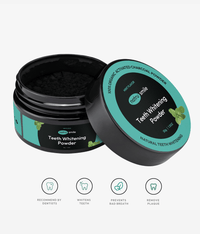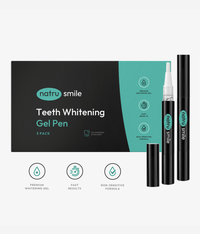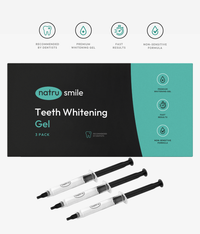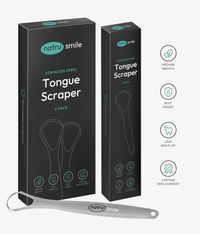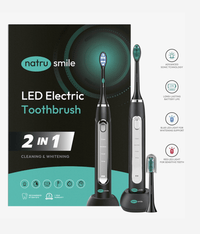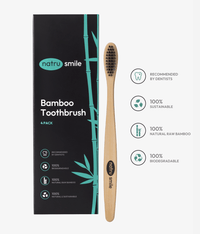
All products are certified by dental expert Dr. Greg Grillo
Your toothbrush is your trusty companion for maintaining a healthy smile, but what do you do when you're without it? Don't fret! There are still ways to clean teeth without a toothbrush.
You aren't alone, either. In fact, the toothbrush is the most frequently forgotten item when traveling, followed by clothing and shoes, then toothpaste.
If you're camping in the great outdoors, forget your toothbrush at home, or run out of toothpaste at the most unexpected time, it's incredibly important to know how to keep your teeth clean using an available alternative to brushing teeth at night to end the day still with sparkling whites.
In this comprehensive guide, we will equip you with a variety of tips and tricks on how to maintain good oral hygiene even when you don't have access to a toothbrush or toothpaste.
No Toothbrush? No toothpaste? No problem: Various Simple Solutions
There are various simple solutions you can try to keep your teeth clean and healthy. Let's explore some of these clever hacks and tips for maintaining fresh breath and a charming smile, even when you're without your usual oral care products.
Brush With A Damp Washcloth Or Paper Towel
If you happen to find yourself in a predicament where you don't have a toothbrush available, a simple and effective way to clean your teeth is by utilizing a damp washcloth or paper towel as an improvised toothbrush.
To do this, wrap the cloth or towel around your index finger, ensuring a solid grip, and then use it to gently rub your teeth and gums with small, circular motions. Be sure to clean all surfaces of your teeth systematically, focusing on removing plaque, food particles, and any other debris that may be lodged between your teeth or along the gumline.
Don't forget to scrape your tongue as well, as this helps eliminate bacteria and improves your breath.
Use The Index Finger To Brush
In situations where a toothbrush or alternative cleaning instrument is unavailable, you can effectively clean your teeth using just your index finger.
First, wet your finger with water, then apply a small amount of toothpaste or an alternative cleaning agent. Next, gently rub your finger on the surface of your teeth, employing small, circular motions to clean each tooth thoroughly.
Make sure to focus on hard-to-reach areas, such as the gum line and the back teeth. Finally, thoroughly rinse your mouth with water to remove any lingering debris or toothpaste residue.
Use Twigs Or Leaves To Brush
When you find yourself in a more remote or natural setting without access to standard dental tools, you can utilize elements from your surroundings to assist you in cleaning your teeth. The use of twigs and leaves, or other natural materials, can be surprisingly beneficial for maintaining dental health.
As an example, the Neem Tree is commonly used in India for oral hygiene through the use of its soft twigs as a natural way to clean teeth without a toothbrush, and its flowers are known to be effective against mouth infections and gum bleeding.
Although neem tree extracts are now commonly used in oral care, the fundamental idea of using its twigs and flowers can still be applied in situations where toothbrushes are not available.
When utilizing leaves, search for plant varieties with known antibacterial properties, such as eucalyptus leaves. These types of leaves not only clean your teeth but also provide added benefits, such as freshening your breath and promoting overall oral health.
To use, simply chew on the leaves, which will release natural juices and fibers, then carefully rub the leaves against your teeth in a brushing motion.
Chew Sugarless Gum
Chewing sugarless gum serves as an excellent alternative to brushing when both a toothbrush and toothpaste are out of reach or unavailable.
Numerous research studies have demonstrated that chewing gum stimulates the production of saliva, which plays a crucial role in neutralizing and rinsing away acidic plaque byproducts that can cause tooth decay.
However, it's important to choose sugarless gum or those sweetened with xylitol, as these options are far less likely to contribute to the development of cavities compared to their sugar-containing counterparts.
Additionally, sugarless gum can be an effective tool for freshening breath, ensuring overall oral health when more traditional dental tools are unavailable.
Use Mouthwash
Mouthwash can serve as a practical temporary solution for cleaning your teeth without a toothbrush. By swishing mouthwash around your mouth for approximately 30 seconds to a minute, you can help eliminate harmful bacteria and reduce some plaque buildup on your teeth.
Different mouthwashes can come with varying benefits – some of which may cater specifically to combating bad breath. As a result, utilizing the appropriate mouthwash can help freshen your breath even when toothbrushing is not feasible.
Floss Your Teeth
Flossing plays an equally integral part in maintaining good oral hygiene and should not be dismissed, even when a toothbrush is inaccessible.
Regular flossing effectively removes plaque and tiny food particles caught between your teeth, warding off cavity formation and gum disease. An ideal flossing routine involves flossing at least once a day, but more frequent flossing may be needed depending on your oral health needs.
Forgotten Toothpaste: Alternative Solutions
We've all been there - you're getting ready for bed, and you realize you've forgotten to get new toothpaste.
It can be frustrating and leave you wondering how you're going to get your teeth clean and fresh. The good news is that there are alternative solutions that can be just as effective.
Using Mouthwash In Place Of Toothpaste
In situations where you have access to a toothbrush but not toothpaste, you can leverage the benefits of mouthwash as an alternative.
To do so, simply apply a small amount of mouthwash to your toothbrush and continue with your normal toothbrushing routine. The antimicrobial properties present in mouthwash aid in protecting your teeth and gums from bacteria and plaque, while the foaming action associated with mouthwash helps dislodge debris when brushing.
However, keep in mind that using mouthwash as a toothpaste substitute should only be done on a short-term basis and doesn't fully replace the benefits provided by toothpaste.
Baking Soda And Water: A Natural Toothpaste Substitute
Baking soda, commonly found in most households, can serve as a natural toothpaste alternative.
To create an effective cleaning solution, take a teaspoon of baking soda and mix it with a small amount of water, forming a paste-like consistency. Use your regular toothbrush and apply the baking soda paste onto your teeth as you would regular toothpaste.
The mild abrasiveness of baking soda serves as a gentle yet effective cleaning agent, removing stains and plaque buildup. Moreover, baking soda neutralizes plaque acids and freshens your breath, ensuring you maintain good oral hygiene even without regular toothpaste.
Brushing With A Wet Toothbrush: A Basic Cleaning Technique
When toothpaste is not available, a straightforward approach is to wet your toothbrush and use it to clean your teeth.
You can do this by dipping your toothbrush in clean water to moisten the bristles, then brushing your teeth in circular motions, making sure to clean all surfaces, including the gum line and other hard-to-reach areas.
While this method doesn't provide the complete range of benefits that toothpaste does, it still helps in removing some plaque and food debris, thereby preventing further dental issues.
Remember, these alternative methods can be useful when toothpaste is unavailable, but they should not replace regular toothpaste over the long term. Toothpaste is specially formulated to remove plaque effectively, fight cavities, and keep your teeth healthy and strong. Be sure always to consult with your dentist for personalized oral health advice and recommendations.
Can You Brush Your Teeth With Your Finger?
While you certainly can brush your teeth with your finger, it's important to note that this method is not as effective as using a toothbrush, as we mentioned earlier in this guide.
Your finger lacks the bristles and reach of a toothbrush, which are essential for reaching small crevices and effectively scrubbing away plaque.
However, if you find yourself in a situation where a toothbrush is unattainable, or you've forgotten to pack one, using your finger can be a helpful temporary alternative to help maintain oral cleanliness. You should ensure that your hands are thoroughly washed before brushing your teeth in this manner.
How Can I Clean My Teeth Naturally?
If you're searching for a natural way to brush your teeth without toothpaste, consider trying one of these alternatives:
-
Baking soda - This is known for its mild abrasive properties that can help remove stains and plaque from teeth. Simply dip a wet toothbrush into baking soda powder and brush gently, making sure not to brush too hard to avoid damaging your tooth enamel.
-
Activated charcoal - This has been used for centuries as a detoxifying agent, and it can also help absorb and remove stains from your teeth. Use it in moderation, and always rinse your mouth thoroughly afterward. You can mix a small amount with water to create a paste and brush it on your teeth, or use activated charcoal toothpaste when available.
-
Oil pulling - An age-old oral care technique, oil pulling is a common practice, particularly with coconut oil. It entails swishing oil in the mouth for about 15-20 minutes, with the oil being thought to pull and attach itself to bacteria, thereby promoting tooth cleaning and enhancing oral health.
- Natural resources - In some cultures, people clean their teeth using twigs from specific trees like neem or miswak that have antibacterial properties. If you're interested in this method, ensure you choose a safe and non-toxic plant source.
How Can I Clean My Mouth Without Toothpaste Or Brush?
In the absence of a toothbrush and toothpaste, there are several options available to help maintain oral hygiene.
Chewing sugar-free gum is an effective method for stimulating saliva production, which aids in neutralizing plaque acids, protecting tooth enamel, and removing food particles.
Additionally, using antiseptic mouthwash can kill germs, reduce plaque buildup, and freshen breath when swished for 30 seconds and then spit out.
Swishing water around in the mouth is also an option, as it can remove loose debris and rinse away some plaque acids.
You should be aware that these alternatives are temporary solutions and should not replace regular brushing with a toothbrush and toothpaste.
What Can I Use To Brush My Teeth Instead Of Toothpaste?
Although toothpaste is a widely used option for daily oral care, various alternatives are available for brushing teeth.
Coconut oil, with its antimicrobial properties, can be used as a natural tooth cleaner by swishing it around in the mouth or applying it to a toothbrush like regular toothpaste.
Activated charcoal is also gaining popularity for its absorption and whitening properties. To use it for brushing your teeth, you can mix a small amount with water or coconut oil to create a paste.
Additionally, hydrogen peroxide can aid in removing surface stains and eliminating bacteria. Be sure to dilute it to a safe concentration (usually 3%) before using it as a tooth cleaner.
Is It Okay Not To Brush Your Teeth One Night?
While skipping brushing your teeth occasionally won't have a significant impact on your oral health, it is essential not to make this a frequent habit.
Prolonged periods without brushing can lead to the formation of cavities, gum disease, and bad breath. Continuity in your oral care routine is necessary to maintain a healthy mouth.
Does Hot Water Clean Teeth Better?
The temperature of the water used to rinse the mouth has no significant impact on its ability to clean teeth.
What is more important is the action of brushing and the type of toothpaste used. Brushing teeth twice a day with fluoride toothpaste and flossing daily are key to maintaining good oral hygiene.
Aside from that, it is recommended to visit a dentist regularly for checkups and professional cleanings.
Does Cold Water Damage Teeth?
Cold water itself does not damage teeth. In fact, rinsing your mouth with cold water can be refreshing and help to wake you up in the morning.
However, exposing your teeth to extreme temperatures, such as very hot or very cold water, can cause sensitivity in some people.
If you experience tooth sensitivity or pain when consuming hot or cold foods or drinks, it's recommended to visit a dentist to determine the underlying cause and receive proper treatment.
Is Dry Brushing Harmful?
Dry brushing, or brushing teeth without toothpaste, can be harmful if it's the only method of cleaning teeth used over a prolonged period of time.
Brushing teeth with toothpaste is beneficial since it helps to remove plaque and harmful bacteria from the teeth and gums while also providing fluoride to strengthen the tooth enamel.
Without toothpaste, the bristles of the toothbrush may not effectively remove plaque, and harmful bacteria can grow in the mouth, leading to various dental problems such as gum disease and cavities.
That being said, dry brushing can be a temporary solution when toothpaste is not available, such as when traveling or during emergencies. However, it should not be a regular practice.
Should You Wet Your Toothpaste Before Brushing?
Wetting your toothbrush before applying toothpaste helps the paste adhere better to the bristles, and it may also aid in distributing the toothpaste more evenly throughout your mouth during brushing. This ensures that all surfaces of your teeth are covered and cleaned properly.
That being said, there is no strict rule on whether or not to wet your toothpaste before brushing. It ultimately comes down to personal preference.
Some people prefer to wet their toothbrush before applying toothpaste, while others prefer to apply toothpaste directly to a dry toothbrush.
What's important is that you brush your teeth thoroughly, at least twice a day, for two minutes each time, with fluoride toothpaste, and follow proper oral hygiene practices.
Is It Okay To Dry Brush Every Day?
Dry brushing is not a recommended alternative to brushing teeth at night. Brushing your teeth with toothpaste and water is the most effective way to remove plaque, food particles, and bacteria from your teeth and gums.
When you brush your teeth dry, it can be harsh on your teeth and gums, potentially leading to damage and irritation over time. It can also cause enamel erosion and gum recession, which can increase tooth sensitivity and expose the roots of your teeth.
It is recommended to use a soft-bristled toothbrush with fluoride toothpaste and to brush your teeth at least twice a day for two minutes each time.
Should You Spit After Brushing Your Teeth?
After finishing brushing your teeth, it is best to gently spit out the remaining toothpaste without rinsing your mouth with water. By not rinsing, you allow the fluoride from the toothpaste to continue working on your teeth, providing additional protection against cavities.
In Conclusion
While a toothbrush is the most effective tool for maintaining good oral hygiene, there are several alternatives available when one is not available. From using twigs and leaves to swishing with mouthwash, these solutions can help to remove plaque, freshen your breath, and improve oral hygiene in a pinch.
Having said that, these alternatives are only temporary, and it is strongly recommended that you always brush and floss regularly, as well as visit your dentist for professional cleanings and checkups on a regular basis.


